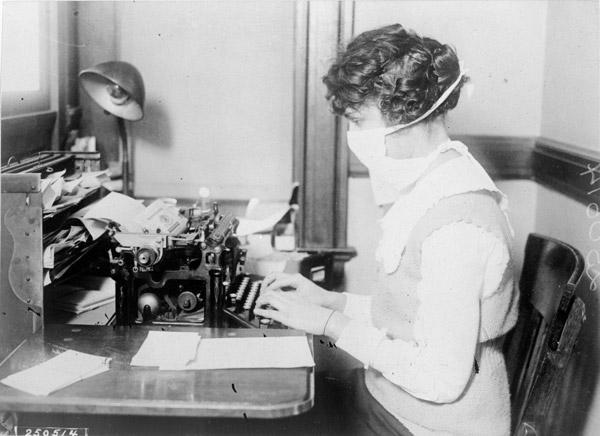 In early April, Reuters ran an article that was picked up by YahooNews titled Closing Schools reduced flu deaths in 1918. I was immediately convinced that archival records must have supported this research – even though no mention of that was included in the article. The article did tell me that it was Dr. Richard Hatchett of the National Institute of Allergy and Infectious Diseases (NIAID) who led the research.
In early April, Reuters ran an article that was picked up by YahooNews titled Closing Schools reduced flu deaths in 1918. I was immediately convinced that archival records must have supported this research – even though no mention of that was included in the article. The article did tell me that it was Dr. Richard Hatchett of the National Institute of Allergy and Infectious Diseases (NIAID) who led the research.
I sent him an email asking about where the data for his research came from. Did the NIH have a set of data from long ago? Here is an excerpt from his kind reply:
Unfortunately, nobody kept track of data like this and you can see the great lengths we went to to track it down. Many of the people we thank in our acknowledgment at the end of the paper tracked down and provided information in local or municipal archives. For Baltimore, I came up and spent an entire day in the library going through old newspapers on microfilm. Some of the information had been gathered by previous historians in works on the epidemic in individual cities (Omaha — an unpublished Master’s thesis — and Newark are examples). Gathering the information was extremely arduous and probably one of the reasons no one had looked at this systematically before. Fortunately, several major newspapers (the NYTimes, Boston Globe, Washington Post, Atlanta Journal-Constitution, etc.) now have online archives going back at least until 1918 that facilitated our search.
Please let me know if you have any other questions. We were amateurs and pulling the information together took a lot longer than we would ever have imagined.
He also sent me a document titled “Supporting Information Methods”. This turned out to be 37 pages of detailed references found to support their research. They were hunting for three types of information: first reported flu cases, amplifying events (such as Liberty Loan Parades ) and interventions (such as quarantines, school closings and bands on public gatherings).
Many of the resources cited are newspapers (see The Baltimore Sun’s 1918 flu pandemic timeline for examples of what can be found in newspapers), but I was more intrigued by the wide range of non-newspaper records used to support this research. A few examples:
- Chicago (First reported case): Robertson JD. Report and handbook of the Department of Health of the City of Chicago for the years 1911 to 1918 inclusive. Chicago, 1919.
- Cleveland (School closings): The City Record of the Cleveland City Council, October 21, 1918, File No. 47932, citing promulgation of health regulations by Acting Commissioner of Health H.L. Rockwood.
- New Orleans (Ban on public gatherings): Parish of Orleans and City of New Orleans. Report of the Board of Health, 1919, p. 131.
- Seattle (Emergency Declaration): Ordinance No. 38799 of the Seattle City Council, signed by Mayor Hanson October 9, 1918.
The journal article referenced in the Reuter’s story, Public health interventions and epidemic intensity during the 1918 influenza pandemic, was published in the Proceedings of the National Academy of Sciences (PNAS) and is available online.
The good news here is that the acknowledgment that Dr. Hatchett mentions in his email includes this passage:
The analysis presented here would not have been possible without the contributions of a large number of public health and medical professionals, historians, librarians, journalists, and private citizens […followed by a long list of individuals].
The bad news is that the use of archival records is not mentioned in the news story.
We frequently hear about how little money there is at most archives. Cutbacks in funding are the norm. Every few weeks we hear of archives forced to cut their hours, staff or projects. Public understanding of the important ways that archival records are used can only help to reverse this trend.
Maybe we need a bumper sticker to hand out to new researchers. Something catchy and a little pushy – something that says “Tell the world how valuable our records are!” – only shorter.
- If You Use Archival Records – Go On The Record
- Put Primary Sources in the Spotlight
- Archivists for Footnotes: Keep the paper trail alive
- Archives Remember: Don’t Forget Them
I don’t love any of these – anyone else feeling wittier and willing to share?
(For more images of the 1918 Influenza Epidemic, visit the National Museum of Health and Medicine’s Otis Historical Archives’ Images from the 1918 Influenza Epidemic.)
Love this idea, maybe SAA or some regional archival organizations would like to use these for future programs, archives weeks, etc. They’re all just as good as SAA’s “Archivists make it last longer!” You can always go to cafepress.com and make some mugs or t-shirts. I’d buy one anyway 🙂
Pingback:Using WWI Draft Registration Cards for Research: NARA Records Provide Crucial Data - SpellboundBlog.com - spellbound by archival science and information technology in the digital age